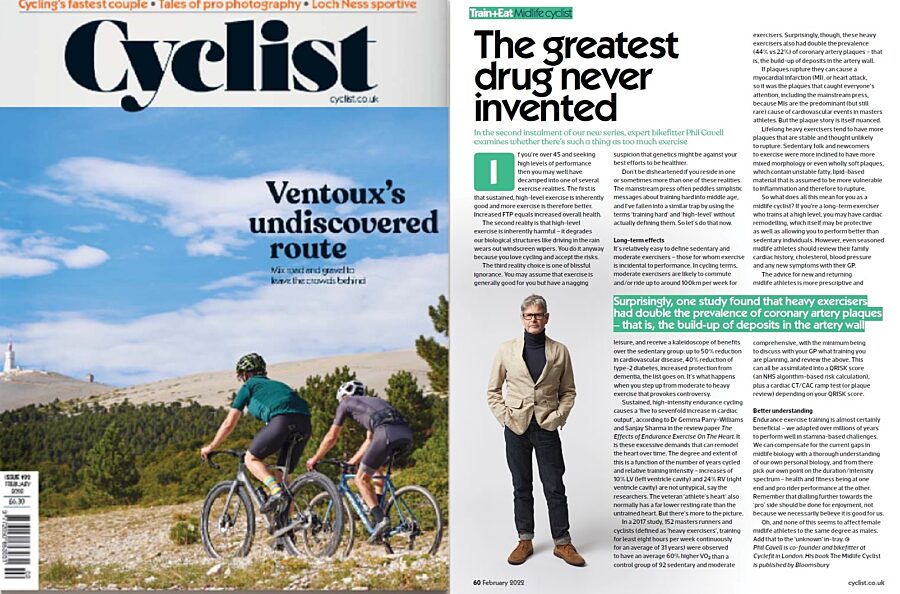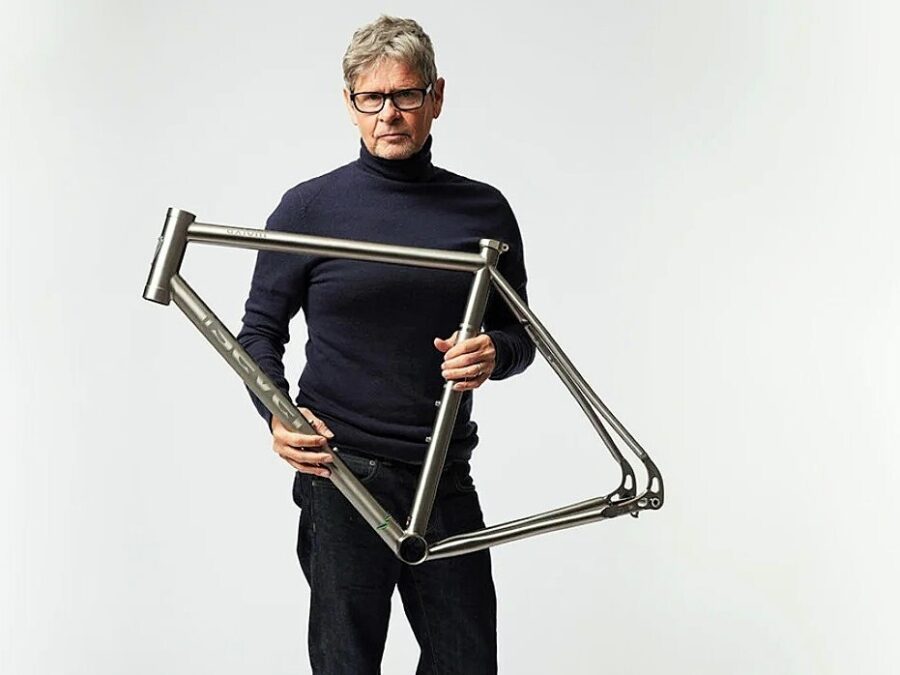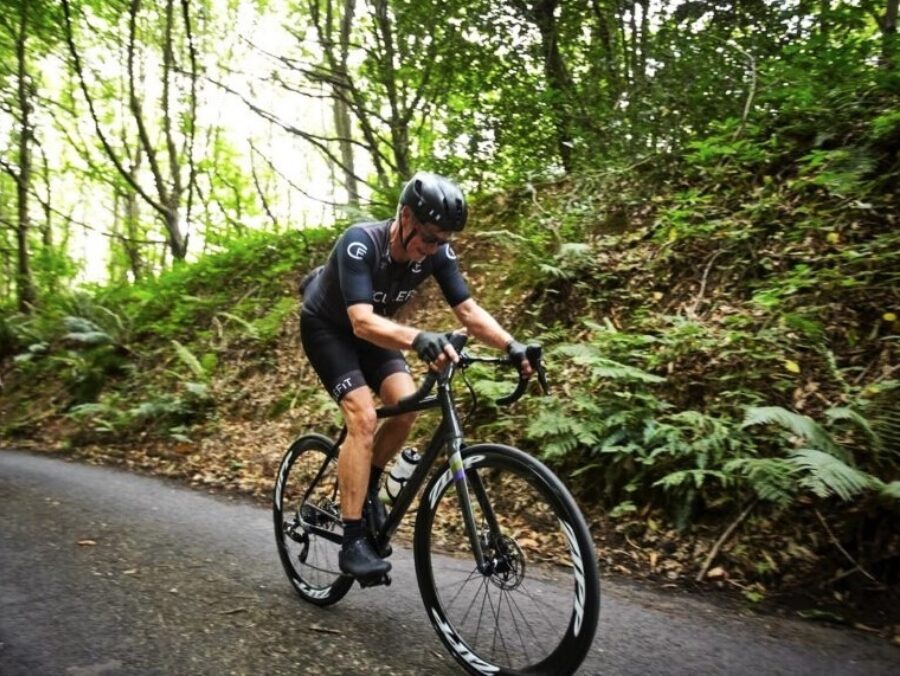"The logical apotheosis of this thought-tent is presumably 7 watts per kg at age 55 and impending immortality?"
The Greatest Drug Never Invented
If you are over 45 and an enthusiastic cyclist, seeking high levels of performance, then you may well have de-camped into one of several exercise realities.
The first is that sustained high-level exercise is inherently good and more exercise is therefore better. Or that fitness and health are interchangeable – ergo: increased FTP equals increased overall health. It is a linear and therefore predictable progression. The logical apotheosis of this thought-tent is presumably 7 watts per kg at age 55 and impending immortality? We will put FTP under a forensic microscope in a future column.
The second is that high-level exercise is inherently harmful – it degrades our biological structures like driving in the rain eventually wears out windscreen wipers. You do it anyway because you love cycling and accept the associated risks. Or maybe that you have migrated to cycling from running, rugby, squash etc, precisely because it is kind to knees, hips, backs, shoulders etc?
The third reality choice is blissful ignorance. You don’t know. You may kind of assume that exercise is generally good for you but have a nagging suspicion that the fitness/health algorithm is wound up tight in the gordian knot of our individual double-helix.
Please forgive yourself if you reside in one, or indeed transition between all these performance/health post-codes. The mainstream press has frequently pedalled simplistic and confusing messages about training hard into middle-age and beyond.
The sharp-eyed reader may have observed that I have already fallen into a common bear-trap myself. I failed to define my terms. I made reference to ‘training hard’ and high-level’, without actually defining what that means.
"But please remember also that the further we dial up towards the ‘Pro’ end of the dial, we are doing because we enjoy it, not because we necessarily believe it is good for us."
Sedentary, Moderate and Heavy Exercisers
Before we define the heavy exercise group, it is relatively easy to define sedentary and moderate exercisers. People who ether do not ‘train’ at all or whose exercise is incidental to performance. In cycling terms, the moderate exercisers are likely to commute and/or ride for leisure up to around 100km per week.
A Kaleidoscope of Physical and Mental Health
It is uncontroversial that moderate exercisers receive a kaleidoscope of physical and mental health benefits over the sedentary group – up to 50% reduction in cardiovascular disease, 40% reduction of type-2 diabetes, increased protection from dementia – etc, etc. It is what happens when you uplift from moderate to heavy exercise that provokes all of the controversy. Sustained high-intensity endurance cycling enacts a massive onslaught to your cardiovascular system, amounting to a:
“fivefold to sevenfold increase in cardiac output” according to Dr Gemma Parry Williams and Mr Sanjay Sharma in The Effects of Endurance Exercise On The Heart review paper.
It is these excessive demands that can adaptively remodel the heart over time. The degree and extent of the cardiac re-structuring is a function of the number of years cycled and of the relative training intensity - increases of 10% LV (left ventricle cavity) and 24% RV (right ventricle cavity) are not untypical (Parry-Williams / Sharma).
The Athlete's Heart
The veteran ‘athlete’s heart’ will normally also have a significantly lower resting rate than the normal untrained heart.
The Merghani, Malhotra, Sharma, St Georges study (2017) of 152 masters runners and cyclists, - defines ‘heavy exercisers’ as training for least 8 hours per week (they were also chosen because they had trained continuously for an average of 31 years). The study group comprised national and world champions and was 70% male and 30% female.
Their control group of 92 individuals comprised of both sedentary and moderate-exercising individuals.
Conflicted Findings
The master athlete group, had, on average, a whopping 60% higher VO2 reading over the sedentary group. But surprisingly, they also had double the prevalence (44% vs 22%) of coronary artery plaques.
Coronary arteries supply vital blood and oxygen to the heart muscle. Plaques are the build-up of deposits in the artery wall. If the plaques rupture, they can cause a myocardial infarction or MI (heart attack). But it was the plaques that caught the attention of everyone, including the mainstream press because MI’s are the predominant (but still rare) cause of cardiovascular events in masters athletes.
All Plaques Are Not equal
But the plaque story is itself nuanced. Lifelong heavy exercisers tend, the study found, to have more calcific plaques that are inherently stable and therefore, it is thought, unlikely to rupture.
Sedentary folk and exercise newcomers were more inclined to have more mixed morphology or even wholly soft plaques – which contain unstable fatty, lipid-based material that is assumed to be more vulnerable to inflammation and therefore rupture.
"The master athlete group, had, on average, a whopping 60% higher VO2 reading over the sedentary group."
The Midlife Cyclist Heart Road-Map
What does all this mean for you as a Midlife Cyclist? If you are a long-term exerciser, who trains at a high level, and you have not taken a long break from riding, then you may have cardiac re-modelling, which itself maybe intrinsically protective, as well allowing you to access enhanced performance over sedentary individuals.
Elite Master bike-racer, cardiologist and Midlife Cyclist contributor, Dr Nigel Stephens reviews your risk profile thus:
“I don’t generally go looking for trouble with lifelong exercisers”
However, even the well-seasoned midlife athletes should review with their GP the following: family cardiac history, cholesterol-levels, blood-pressure and most importantly, a review any new symptoms. The new or returning cyclist will potentially not have the protective effects of decades of high output endurance exercise – Dr Stephens describes this group as relatively as ‘exercise silent’.
Hence the advice for the new and returning midlife athletes in my book is more prescriptive and comprehensive – the minimum would be -
- Discuss with your GP what training you are planning to do.
- Review with your GP – family-history, blood-pressure, cholesterol-levels.
This can all be assimilated into a QRISK (NHS algorithm-based risk calculation) score.
Dr Stephens further recommends a ramp-test, Cardiac CT / CAC score (plaque review) if indicated by QRISK.
Endurance exercise training is almost certainly beneficial in the short, medium and longer-term. We are after all adapted over millions of years, to perform well in stamina-based challenges. But we have also never lived this long and trained so hard - it is precisely this combination that is exercising the clinical academics and guiding their longitudinal research.
We should all ensure that we compensate for the current (and almost certainly temporary) gaps in midlife biology, with a thorough understanding of our own personal biology (blood-pressure, family-history, cholesterol-levels etc). And then maybe pick your own point on the duration/intensity spectrum – health and fitness at one end and ersatz pro-rider at the other. But please remember also that the further we dial up towards the ‘Pro’ end of the dial, we are doing because we enjoy it, not because we necessarily believe it is good for us.
Oh, and none of this seems to affect female midlife athletes to the same degree as males. Add that to the unknown in-tray.
Final word on the matter is from Midlife Cyclist, FT journalist, Jonathan Derbyshire:
“The point Phil makes about what happens when one moves from "moderate" to "heavy" exercise is an important one. I think I was on exactly the cusp of moving from one to the other when I had my heart attack. And I also fell somewhere between the first and third exercise reality choices - though in my case, ignorance (specifically, of my cholesterol levels) turned out not to be blissful, exactly.”
Thankfully Jonathan is back riding to a good level again after insertion of stents into his coronary arteries.
"Oh, and none of this seems to affect female midlife athletes to the same degree as males. Add that to the unknown in-tray"
Phil Cavell is co-founder at Cyclefit in London. His book The Midlife Cyclist is published by Bloomsbury
This Column was first published in Cyclist Magazine - February 2022 and is re-printed here with their kind permission.




